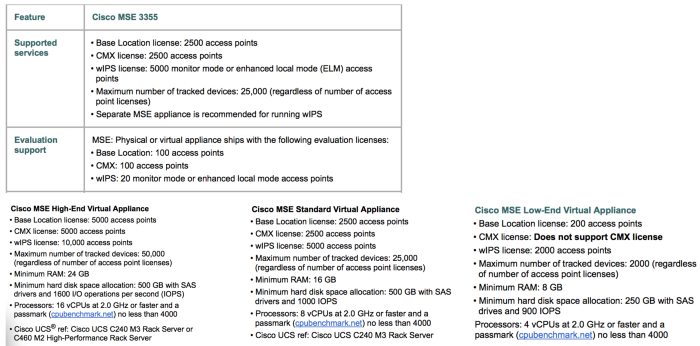Make sure you order the right Licensing PAK’s quantities for your Mobility Services Engine based on software and platform release.

Since the recent release of the free Mobility Services Engine (MSE) Base AP Licenses in late 2013. Mobility folks including myself, jumped at the promotion to max out the base licenses per MSE. What a great opportunity to get your customer introduced to the Cisco Mobility Engine and all of its cool features including WiPS and CMX (Connected Mobile Experience).
Special Thanks
Before we continue, I would like to give a great big “Hats” off to the folks at the ENG (aka WNBU for us legacy crowd) for making this happen. This promotion only last until April 2014. My wish is that they keep this running permanently.
Now for the meat and potatoes:
As you read further on, keep in mind that the NEW MSE Licensing scheme is now based on AP’s (Access Points){which can be used with Cisco Prime Infrastructure 1.4 and 2.0} instead of the traditional CAS (Contextual Aware Service). This only becomes enforceable until the release of MSE version 8.x. So don’t worry about your existing CAS licensing on earlier Prime/MSE platforms, they will be auto converted to AP licences once you move to Prime 1.4+. Confused yet? Don’t worry I will try to explain.
There are a few things you need to be aware of when it comes to licensing an MSE per release version. The first thing you need to do is check out the Mobility page on Cisco.com Take a close look at the MSE Product Specifications limitations based on platform.
Wow those numbers are excellent. Especially for the MSE 3355 physical appliance where you can license up to 2500 Base Location Licences.
Here are the gotcha’s
Be aware that the data sheet does not mention what code you should be running, so we have to assume its the latest release. But as you and I know we can not always upgrade our code beyond what Prime Infrastructure Supports for obvious SLA reasons. (which is being worked on by the PI folks).
Cisco Prime Infrastructure 2.0 Compatibility matrix reference.
I have highlighted the supported AP licence count based on version of MSE platform. What this means is when you go to apply the actual L-MSE-PAK’s in Prime you will have to engage Cisco TAC Licensing to either break up the PAKs into 500’s to be able to import into 7.4 x to 7.4.121.0.
Another alternative is when ordering your MSE License PAK’s, work with your Cisco Partner to make sure that the PRO-L-LS-1000AP is broken up into separate line items or PAK’s as this will at least help you make your adding of licensing less painful.
Example
L-MSE-PAK’s
PRO-L-LS-1000AP QTY 3 = 3000 AP LIC cannot be added to MSE when it supports 500 AP’s based on certain versions of code.
Below is a breakdown of MSE release notes based on version
7.4.100.0
http://www.cisco.com/en/US/docs/wireless/mse/3350/release/notes/mse7_4_100_0.html#wp1247250Cisco MSE 3355 supports up to 500 access points for Cisco MSE Location Services or Advanced Location Services. The Cisco MSE virtual appliance supports up to 1,000 access points, depending on the server resources. There is no change to endpoint support and MSE 3355 supports 25,000 and high-end virtual alliance supports 50000.
7.4.121.0
http://www.cisco.com/en/US/docs/wireless/mse/3350/release/notes/mse_7_4_121_0.html#wp1259797Cisco MSE 3355 supports up to 500 access points for Cisco MSE Location Services or Advanced Location Services. Cisco MSE virtual appliance supports up to 1,000 access points, depending on the server resources. There is no change to endpoint support and MSE 3355 supports 25,000 and high-end virtual alliance supports 50000.
7.5.102.101
http://www.cisco.com/en/US/docs/wireless/mse/3350/release/notes/mse7_5_102_101.html#wp1247250Cisco MSE 3355 supports up to 2,500 access points for Base Location/CMX or 5000 access points for wIPS. Cisco MSE virtual appliance supports up to 5,000 access points, depending on the server resources for Base Location/CMX or 10,000 access points for wIPS. All licenses are additive. The new scaling numbers for Base Location and CMX licenses are as follows:
–For Low End VA—200APS
–For 3355 MSE and Standard VA—2500APS
–For High End VA—5000APS
There is no change to endpoint support and MSE 3355 supports 25,000 endpoints and high end virtual appliance supports 50000.7.6.100.0
http://www.cisco.com/en/US/docs/wireless/mse/3350/release/notes/mse7_6_100_0.html#wp1329798Cisco MSE 3355 supports up to 2,500 access points for Base Location/CMX or 6000 access points for wIPS. Cisco MSE virtual appliance supports up to 5,000 access points, depending on the server resources for Base Location/CMX or 10,000 access points for wIPS. All licenses are additive. The new scaling numbers for Base Location and CMX licenses are as follows:
–For Low End VA—200APs. Low end VA does not support CMX licenses.
–For 3355 MSE and Standard VA—2500APs
–For High End VA—5000APs
There is no change to endpoint support and MSE 3355 supports 25,000 endpoints and high-end virtual appliance supports 50000.
Shameless Plugs
If you need a refresher on what the Cisco MSE does, look no further than the Geeks You Can Trust @TechwiseTV @Robbboyd on the Fundamentals of the Mobility Services Engine on http://youtu.be/OJ21P6VQxB4 and @JimmyRay_Purser In the Lab: Deploying the Mobility Services Engine http://youtu.be/XFUiTD3SLpM

And last but not least, don’t forget to check out a two other Wireless Guru’s, Blake Krone and Sam Clements on the @NSAShow E17 – Enhancing Your Wireless With A MSE
Disclaimer: I was not approached or offered any endorsement for this post. This is just something I wanted to share because I like things without wires. Also I couldn’t find it on google.
@WirelessStew











